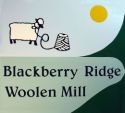
 |
| What's New | Knitting Patterns and Kits | Yarn | Knitting Needles | Machine Knit Socks | Custom Carding and Spinning | Home |
1. Sheep Wool comes from sheep. They grow a wool coat and once a year this wool coat is sheared off the animal. In Wisconsin, this is frequently done in the early spring shortly before they have their lambs. A shorn ewe will be more likely to stay out of the wind and bad weather and protect her new-born lamb if she does not have a thick wool coat on her. | |
2. Fleece The shorn wool coat is called a fleece. It is also called "grease wool" because of all the oil and lanolin in the wool. This fleece must be cleaned before it can be processed into wool yarn. There is much vegetable matter, manure and natural oil that must be removed. Sometimes as much as 50% of the weight of the fleece is not wool. | |
|
3. Skirting a fleece | |
4. Washing the wool The grease must then be removed from the wool. This can be done using soap or detergent and a lot of water or it can be done by submerging the wool in an acid bath which dissolves all the vegetable matter as well as the grease (this is called scouring). | |
5. Picking The washed and dried wool is then "teased" or "picked" which is the beginning of the process of opening up the locks of wool and turning it into a consistent web. The wool is put through a picker which opens the locks and blows the fluffy wool into a room. At the same time a special spinning oil is added which helps the wool fibers slide against each other but also helps them stick together as a fine web through the processing. | |
6. Carding
The wool fibers are then put through a series of combing steps called
carding. This can be done with small hand cards that look much like
brushes you would use on a dog. It can also be done on a larger scale
with machine driven drums covered with "card cloth" which combs the
wool many times by transfering it back and forth from one drum to the
other as it is passed down the series of drums. We have "woolen"cards
which produce a wool web with the fibers coming off in random
alignment. This is in contrast to "worsted" combing that lines up all
the fibers (as you would see in thread). | |
7. Roving The final step in the carding process divides the web into small strips called pencil rovings. These are collected on large spools on the end of the card. These spools of pencil roving will be placed on the spinning frame to make yarn. Pencil roving is too delicate to be handled much, so when proccessing fiber for handspinners the roving is taken off the machines earlier and wound into balls. | |
8. Spinning | |
9. Wind and/or skeining When the wooden bobbins are full of yarn, they are placed on a cone winder and the yarn is transferred to paper cones for use in weaving and knitting machines. It could also be put into skeins of yarn which are the form that knitters like to use. | |
|
10. Finishing | |
3776 Forshaug Rd, Mount Horeb WI 53572, 608-437-3762
Please direct comments or questions to: Anne@blackberry-ridge.com